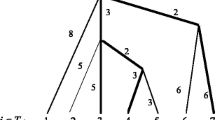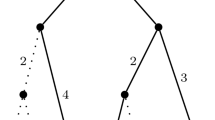Abstract
Arising in the context of biodiversity conservation, the Budgeted Nature Reserve Selection (BNRS) problem is to select, subject to budgetary constraints, a set of regions to conserve so that the phylogenetic diversity (PD) of the set of species contained within those regions is maximized. Here PD is measured across either a single rooted tree or a single unrooted tree. Nevertheless, in both settings, this problem is NP-hard. However, it was recently shown that, for each setting, there is a polynomial-time \({(1-\frac{1}{e})}\) -approximation algorithm for it and that this algorithm is tight. In the first part of the paper, we consider two extensions of BNRS. In the rooted setting we additionally allow for the disappearance of features, for varying survival probabilities across species, and for PD to be measured across multiple trees. In the unrooted setting, we extend to arbitrary split systems. We show that, despite these additional allowances, there remains a polynomial-time \({(1-\frac{1}{e})}\) -approximation algorithm for each extension. In the second part of the paper, we resolve a complexity problem on computing PD across an arbitrary split system left open by Spillner et al.
Similar content being viewed by others
References
Bordewich M, Rodrigo AD, Semple C (2008) Selecting taxa to save or sequence: desirable criteria and a greedy solution. Syst Biol 57: 1–11
Bordewich M, Semple C (2008) Nature reserve selection problem: a tight approximation algorithm. IEEE/ACM Trans Comput Biol Bioinforma 5: 275–280
Bryant D, Huson D (2006) Applications of phylogenetic networks in evolutionary studies. Mol Biol Evol 23: 254–267
Faith DP (1992) Conservation evaluation and phylogenetic diversity. Biol Conserv 61: 1–10
Faith DP (1994) Phylogenetic pattern and the quantification of organismal biodiversity. Philos Trans Biol Sci 345: 45–58
Faller B (2010) Combinatorial and probabilistic methods in biodiversity theory. Dissertation, University of Canterbury
Feige U (1998) A threshold of ln n for approximating set cover. J ACM 45: 634–652
Minh BQ, Klaere S, von Haeseler A (2009) Taxon selection under split diversity. Syst Biol 58: 586–594
Minh BQ, Klaere S, von Haeseler A (2010) SDA*: a simple and unifying solution to recent bioinformatic challenges for conservation genetics. In: Proceedings of the second international conference on knowledge and systems engineering, pp 33–37
Moritz C, Faith DP (1998) Comparative phylogeography and the identification of genetically divergent areas for conservation. Mol Ecol 7: 419–429
Moulton V, Semple C, Steel M (2007) Optimizing phylogenetic diversity under constraints. J Theor Biol 246: 186–194
Nemhauser GL, Wolsey LA, Fisher ML (1978) An analysis of approximations for maximizing submodular set functions—I. Math Program 14: 265–294
Pardi F, Goldman N (2005) Species choice for comparative genomics: being greedy works. PLoS Genet 1: e71
Pardi F, Goldman N (2007) Resource-aware taxon selection for maximizing phylogenetic diversity. Syst Biol 56: 431–444
Rodrigues ASL, Gaston KJ (2002) Maximising phylogenetic diversity in the selection of networks of conservation areas. Biol Conserv 105: 103–111
Rodrigues ASL, Brooks TM, Gaston KJ (2005) Integrating phylogenetic diversity in the selection of priority areas for conservation: does it make a difference. In: Purvis A, Gittleman JL, Brooks T (eds) Phylogeny and conservation. Cambridge University Press, Cambridge, pp 101–119
Smith TB, Holder K, Girman D, O’Keefe K, Larison B, Chan Y (2000) Comparative avian phylogeography of Cameroon and Equatorial Guinea mountains: implications for conservation. Mol Ecol 9: 1505–1516
Spillner A, Nguyen B, Moulton V (2008) Computing phylogenetic diversity for split systems. IEEE/ACM Trans Comput Biol Bioinforma 5: 235–244
Steel M (2005) Phylogenetic diversity and the greedy algorithm. Syst Biol 54: 527–529
Sviridenko M (2004) A note on maximizing a submodular set function subject to a knapsack constraint. Oper Res Lett 32: 41–43
Author information
Authors and Affiliations
Corresponding author
Additional information
M. Bordewich was supported by the EPSRC, while C. Semple was supported by the New Zealand Marsden Fund.
Rights and permissions
About this article
Cite this article
Bordewich, M., Semple, C. Budgeted Nature Reserve Selection with diversity feature loss and arbitrary split systems. J. Math. Biol. 64, 69–85 (2012). https://doi.org/10.1007/s00285-011-0405-9
Received:
Revised:
Published:
Issue Date:
DOI: https://doi.org/10.1007/s00285-011-0405-9
Keywords
- Combinatorial algorithms
- Phylogenetic diversity
- Biodiversity conservation
- Split systems
- Submodular functions




